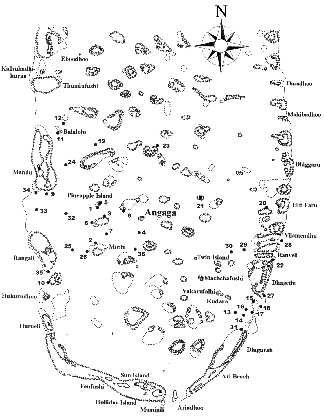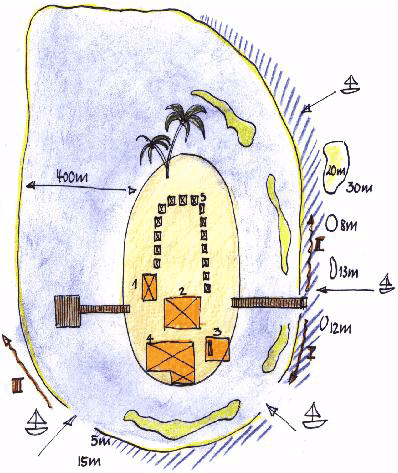

Figure 1: Southern part of the South Ari Atoll indicating the geographic location of Angaga island as well as many diving sites.
The variety of animals is similarly small: 2 grey heron (Ardea cinerea), 3-4 hooded crows (Corvus corone cornix), geckos, palm tree rats, crabs and hermit crabs.

Figure 2: Schematic plan of Angaga Island.1: Divingcentre, 2: Reception, 3: Coffee Shop, 4: Restaurant and 5: Bungalows. The roman numbers I-III refer to the location of the transects in the housereef.
Tourism
The main season on Angaga lasts from December till March. Most people
visiting Angaga are relaxing from the stress of everyday life by enjoying
sun, sand and water together with the luxury of the recreational resort.
The variety of sport activities and entertainment organized by the resort
staff depends on the number of guests. Activities include sailing, surfing,
banana riding, water skiing, angling etc. as well as nightly entertainment
in the bar. Moreover, the staff organizes daily and half-day excursions
to tourist resorts and to native Maldivian islands to learn more about
their culture and for shopping. The leader of the excursions advises his
group to refrain from buying any souvenirs made of black coral or turtle-shell
as well as buying rare animals such as triton shells (Charonia tritonis).
The Maldivian law is very strict on these terms e.g. even export coral
sand as a souvenir is illegal.
Scuba Diving
The headquarter of the Subaqua dive base on Angaga is located in Germany
supervising and coordinating several dive bases in the Maldives as well
as other places in the world. For five years now, the dive base on Angaga
is supervised and run by Jochen Gommers. Depending on the time of the year
he is working with one to three dive masters and instructors. Generously
Jochen and his crew supported our efforts and supplied us not only with
missing diving equipment but also by helping in the transects.
During our investigations, there were only up to 30 guests including 1-4 scuba divers. Human impact on the coral reefs around Angaga seems rather low. Only advanced scuba divers are allowed to dive without supervision by people from the dive base and only in the housereef. The people from the dive base try to minimize the impact of scuba divers in order to keep the diving sites attractive.